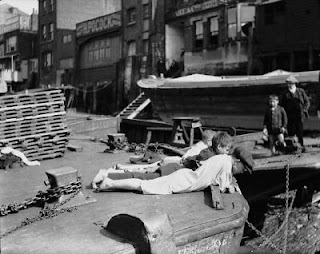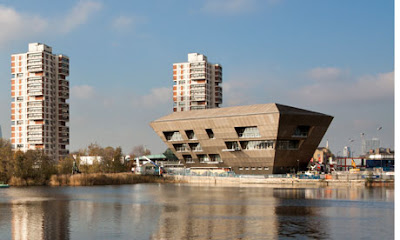Three quarters of its exterior is still immersed in building works but the front door was easy to find and opened into a large space with a security guard sitting on a pedestal, a bit like a Wimbledon referee, a small reception desk, some computer consoles and, at the opposite end, a cafe. Some shelves appeared to be offering the latest best sellers. It seemed like a big space, poorly used.
Joining required a piece of identification which had an address (I used my driving license), and took only two minutes. The result was a credit-card sized plastic card with a membership number clearly marked.
I asked the receptionist, a nice lady, for a map, and although she had no idea whether there was one she found one in a brochure holder for me. It showed that there were two library floors. At the elevetor there was a sign showing which subjects were on each floor. History, the topic where I thought I would start, was on the top (second) floor.

I made my way to the stairs. The stairs confirmed my first impression of poorly used space, an unalterable part of the design, a mistake that cannot be corrected. It is true that the stairs are aesthetically very pleasing - a vast open wooden spiral leading from the ground floor to the first floor, using up an enormous amount of floor space on the first floor. A complete and utter waste of valuable space.
The second floor is not, in fact, an entire floor but a mezzanine or gallery - a narrow corridor that follows the perimeter of the library, and looks out over the first floor. Why? Why not put in an entire floor? My bewilderment increased when I climbed the steps to reach that level. The wall was lined with shelves carrying books, language tapes and the like. On the edge looking over the void was either empty wall or banks of desks and chairs with wall sockets for laptops. The few desks that were provided were full with people plugged in with their laptops - some with books, but most apparently surfing the web on the free wi-fi.
The history section, when I found it, was quite small. Looking specifically for local history I found that I have a much, much bigger collection of Rotherhithe and Thames books and information than the library has, which is a bit sad.
Back on the first floor, with a couple of local history books in my hands (you can take out up to 15) I had a wander round to see what the seating was like down there. It was almost non-existant. A small row of swivel chairs with views over Canada Water were fully occupied, and the few desks were taken. A numebr of desks with computers on them were free, but when I tried to log on using my full membership number (observing the rule that it was case sensitive) my number was rejected.
I continued my wander around the first floor and found myself at a childrens book section which, sadly, had a children's play area attached. There were only two children there but they were already disturbing the peace. Why? Why not put the kids books and the kids themselves down with the cafe in the under-utilized ground floor space and free more area upstairs for the much-needed work stations?
The books at the Canada Water library must represent a tiny fraction of the numbers that used to be held in the Albion Street library before it closed (now, apparently, about to be developed as yet more high rise housing). Overall, between the two libarary floors, I would be fascinated to see how the numbers between the new library and the old one compare, and how the content type breaks down, and how topics were chosen.
Back on the ground floor, still clutching my books, I asked the receptionist how to sign out my loans. He was very helpful and explained that it was self-service and showed me how to use the machine, which was straight forward (if a bit reluctant to accept some of my books). At the same time I asked him why my log-in had failed on the PC that I had tried and he gave me the essential piece of information missing from the log-in screen - you only enter the numbers, not the letters. It would have been SO useful if, instead of telling me that my membership code was case-sensitive, the log-in screen had told me to elminate the letters from in front of the number. And how can a number be case sensitive anyway? Silliness.
I cannot understand how someone granted it planning permission given that it simply doesn't make any sensible use of the internal space. The second floor is no bigger than a corridor, the first floor has two huge holes eaten out of it by the massive central stairwall and the children's play area, and the ground floor is simply underutilized. The lack of desk space would be laughable if it wasn't so damned infuriating.
Why the Council should feel the need to provide free wi-fi to anyone who happens to live in the area I cannot imagine - it is obvious that it will become a free Internet Cafe for people checking up on their Twitter and Facebook accounts rather than a resource for researchers and studying students.
What a complete waste of space, quite literally. Why the Council should have allocated planning permission to something that is more space than actual content I really cannot understand.
Someone told me today that we, the taxpayers, payed £14 million for that farce.
So I am now the happy owner of a membership card for a facility that cannot provide me desk space. Thanks, Southwark Council!







